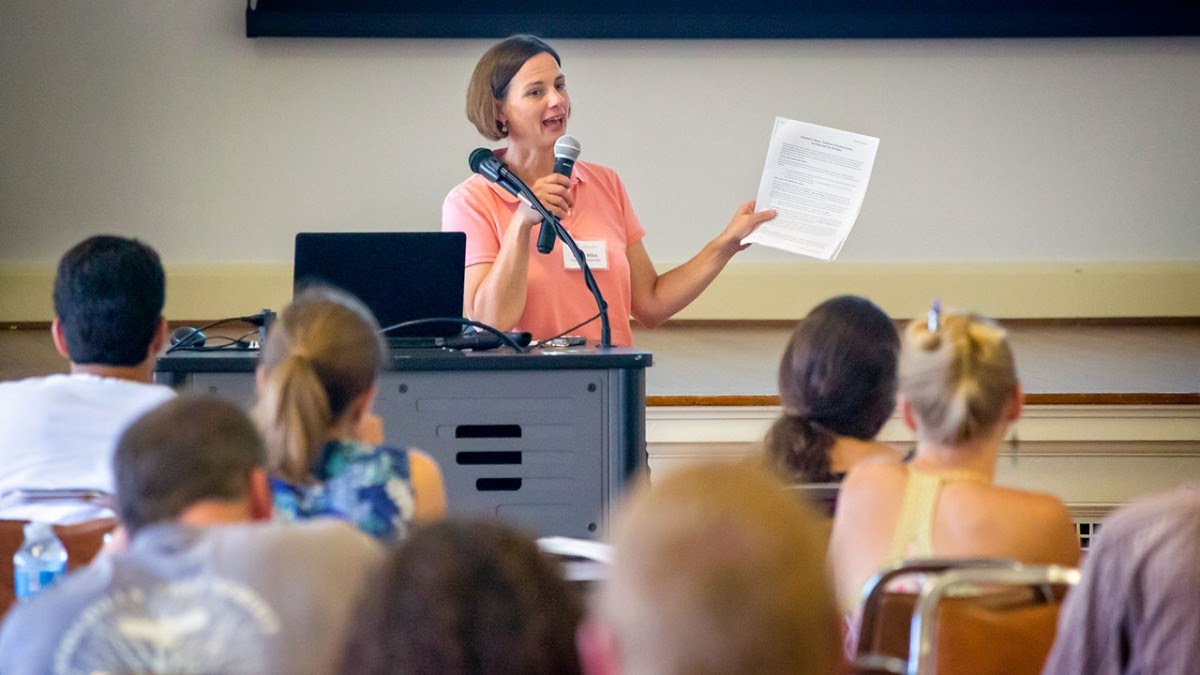Study Finds Food Safety Practices Benefit Small Farmers
A new Cornell study finds that when small-scale farmers are trained in food safety protocols and develop a farm food safety plan, their access to new markets leads to gains in revenue.

Elizabeth Bihn, director of the Produce Safety Alliance, conducts a food safety training.
Courtesy of Rob Way
The costs of implementing food safety practices to prevent foodborne illnesses have been viewed as a threat to the financial well-being of fruit and vegetable producers – particularly small farms, which must pay a higher percentage of their annual sales than larger farms to meet safety standards.
But a new Cornell study finds that when small-scale farmers are trained in food safety protocols and develop a farm food safety plan, new markets open up to them, leading to an overall gain in revenue.
“Our results should be welcomed by growers in understanding that food safety investments can support both reduced microbial risks and sales growth,” said Todd Schmit, associate professor in the Charles H. Dyson School of Applied Economics and Management.
Schmit is lead author of “Assessing the Costs and Returns of On-Farm Food Safety Improvements: A Survey of Good Agricultural Practices (GAPs) Training Participants,” which was published July 2 in the journal PLOS ONE.
“The study highlights the value of food safety to all farmers,” said study co-author Elizabeth Bihn, Ph.D. ’11, director of the Cornell-based National GAPs Program and the Produce Safety Alliance, a collaborative project between Cornell, the USDA and the FDA. “It’s great to know that by investing in food safety, you are actually getting a market benefit.”
In 1998, the FDA released a guide for good agricultural practices (GAPs) to minimize microbial food safety hazards for fresh fruits and vegetables. Though the recommendations for farmers were voluntary, many buyers – including grocery stores and wholesale buyers, farm-to-school programs, and food distributors – demanded growers follow GAPs guidelines as a requisite for doing business. For verification, buyers commonly request that growers get a third-party audit. The National GAPs Program and Cornell Cooperative Extension began offering a multiday GAPs training program in 2008 to help growers create a farm food safety plan, a necessary step to passing an audit.
In the study, food scientists, Extension educators, and economists surveyed 80 New York State farms that had previously participated in the multiday GAPs trainings. Extension educators visited farms and conducted in-person interviews with farmers. Educators asked the farmers about costs of implementing GAPs, which can include washing stations, coolers, and new employees to monitor and record food safety steps and actions. They also asked about the financial benefits.
“What we found is that, consistent with the literature,” Schmit said, “the relative cost burden is higher for smaller-scale producers, but they also have more relative benefits of increasing sales to new markets and buyers.”
Also, when profitability of small and large farms were compared, the researchers found the relative benefits from getting GAPs certified were roughly the same overall.
In 2015, the FDA completed its Food Safety Modernization Act (FSMA) Produce Safety Rule, a set of specific actions growers must take to prevent contamination from foodborne pathogens. While GAPs certification is voluntary, market-driven, and requires an audit, FSMA compliance is mandatory and farms receive inspections.
FSMA compliance has begun on a rolling basis based on the size of farms, though small farms with average annual food sales of $500,000 or less and farms that grow certain types of produce can qualify for an exemption and don’t require compliance. This makes continued GAPs training, audits, and certification necessary for smaller producers.
“It is important to note that markets drove food safety requirements before FSMA,” Bihn said, “and will likely continue to drive markets given that FSMA exempts or excludes certain farms.”
In the future the researchers hope to do similar types of surveys and analyses in other parts of the country, specific to the FSMA implementation.
Co-authors include Gretchen Wall, a coordinator and Northeast regional Extension associate at the Produce Safety Alliance; and Elizabeth Newbold, center administrator for the Northeast Center to Advance Food Safety.
This article originally appeared in the Cornell Chronicle.

